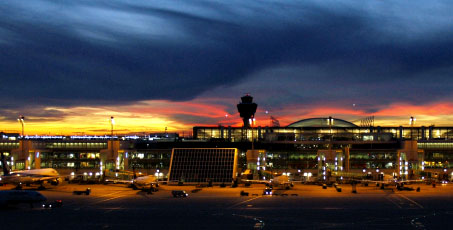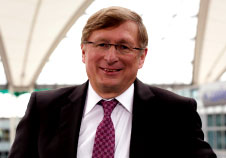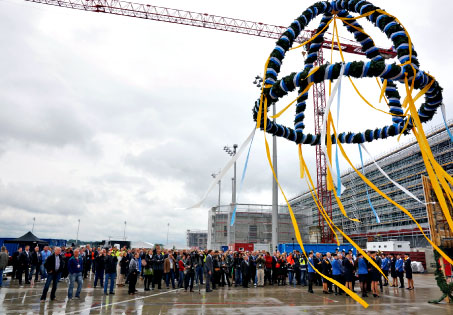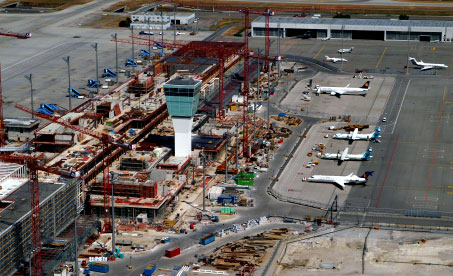
Munich Airport handled a record 38.4 million passengers in 2012 and growth has continued in 2013, with a record 18.6 million passengers handled in the first half of the year.
Munich Airport achieved a new passenger record of 18.6 million for the first half of 2013, with more capacity offered by Lufthansa and other airlines, and an increased average load factor of 74.5%. It follows a record 2012, in which 38.4 million passengers were handled (+1.6% year-on-year), and points to further growth this year. This success mirrors the general business environment in the Munich region, which is experiencing strong economic growth. Bavaria is one of Europe’s most successful regions, with a highly export-driven economy that makes it reliant on good access to air transport. The high quality connections provided by Munich Airport help sustain the region’s economic strength and continued growth. Indeed, the airport is an employment engine, supporting 32,000 jobs – up by 2,800 since 2009.
The airport is responding to growth with the new Terminal 2 satellite, which will provide capacity for an additional 11 million passengers per year when it opens in 2015. The €650 million project is being funded by Munich Airport and Lufthansa on a 60:40 basis, in a similar arrangement to the original Terminal 2 development. The topping-out ceremony for the facility – the first midfield terminal to go into operation at a German airport – took place in September.
“The project is on schedule; the traffic lights are on green,” commented Dr. Kerkloh. He added that the second stage of the satellite development is already masterplanned: “This is a built-in option of the satellite, and would increase the total annual passenger capacity to 17 million. With that order of magnitude, we cannot overstate the importance of the satellite for the future development of our airport.”
Munich’s strategic potential

Dr. Kerkloh: “We have a lot of strategic potential and the satellite is the next step in establishing Munich Airport as one of the main European hubs. Overall capacity with the satellite will be 50 million passengers per year.”
This expansion of Terminal 2, which is operated jointly by Munich Airport and Lufthansa, is necessary because its capacity of 25 million passengers per year is now stretched to the limit. The 10th anniversary of Terminal 2 was celebrated in June – in that time, 225 million travellers have used the terminal. “This terminal has yielded huge benefits for our airport by enhancing its appeal and adding to its clout. Until June 28, 2003, this was an impressive medium-sized international airport, both architecturally and from a functional standpoint. With the launch of the new terminal, we became a thriving air transportation hub ranked alongside Europe’s top airports,” explained Dr. Kerkloh. The statistics underline the success of the facility; in its 10 years of operation, the annual passenger volume has risen from 16 million to 27 million. In 2003 Lufthansa was serving 71 destinations from Munich; today it serves 125. Meanwhile, long-haul services, which are so vital to Bavaria and its export-driven economy, have almost tripled from eight to 23.

The topping-out ceremony for the new Terminal 2 satellite – the first midfield terminal to go into operation at a German airport – took place in September.
The satellite facility is being built on top of the baggage sorting hall on the airport’s eastern apron as a functional element of Terminal 2, and will have 52 departure gates. It is not a standalone terminal, as it has no landside transportation links; passengers arriving or departing through the satellite will use the check-in and baggage reclaim facilities in the main Terminal 2. The two buildings will be linked by an underground personal transportation system (PTS).
“We have a lot of strategic potential and the satellite is the next step in establishing Munich Airport as one of the main European hubs. Overall capacity with the satellite will be 50 million passengers per year. The satellite provides 27 new air bridges and contact stands – more than doubling the current number of positions linked to Terminal 2 via passenger bridges. This will accommodate most of the aircraft that currently have to be handled on remote stands,” added Dr. Kerkloh.
He also highlighted the lounge facilities – the five Lufthansa lounges in the satellite will double the number of lounges available in and around Terminal 2. “Munich Airport has a fairly high proportion of high yield passengers. The new satellite will provide these facilities to a very high standard,” he commented.
A 9,000sqm area is dedicated to retail and F&B, and with the open layout filled with natural light, and the wide variety of shops, the satellite will offer an excellent passenger experience.

The Terminal 2 satellite project is progressing on schedule. The façade is under construction, and the interior work and installation of technical equipment is also underway. Meanwhile, seven connecting structures for the new passenger bridges have already been installed.
As Dr. Kerkloh explained, the project is progressing on schedule. The façade is under construction, and the interior work and installation of technical equipment is also underway. Meanwhile, seven connecting structures for the new passenger bridges have already been installed.
Ambitious environmental agenda
Munich Airport has a strict environmental agenda, and is accredited at Level 3 – Optimisation – of ACI EUROPE’s Airport Carbon Accreditation programme. In 2012, it also became the first German airport to sign-up to the German Sustainability Code (DNK), which now has more than 50 listed and mid-sized corporations from various sectors among its members – all with ambitious sustainability targets within their corporate strategies. The airport’s stated goal, since 2010, has been to become one of the world’s most sustainable hub airports by 2015. The new satellite has been designed in accordance with sustainable construction principles – its carbon footprint will show a 40% improvement over the airport’s two existing terminals.
The new satellite building takes the Bavarian hub to a new dimension. It is a vital step not only in the future growth of Terminal 2 and Lufthansa’s operations at Munich, but for the airport as a whole, further enhancing the passenger experience.







